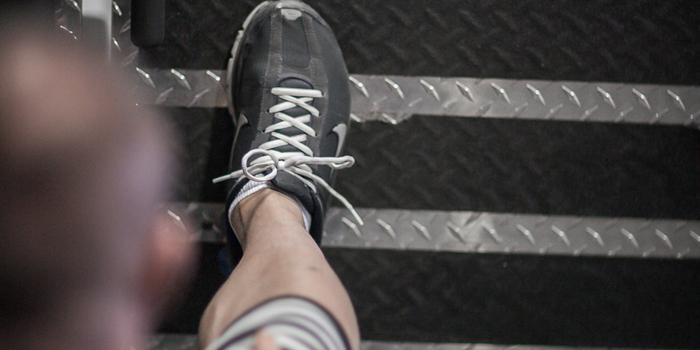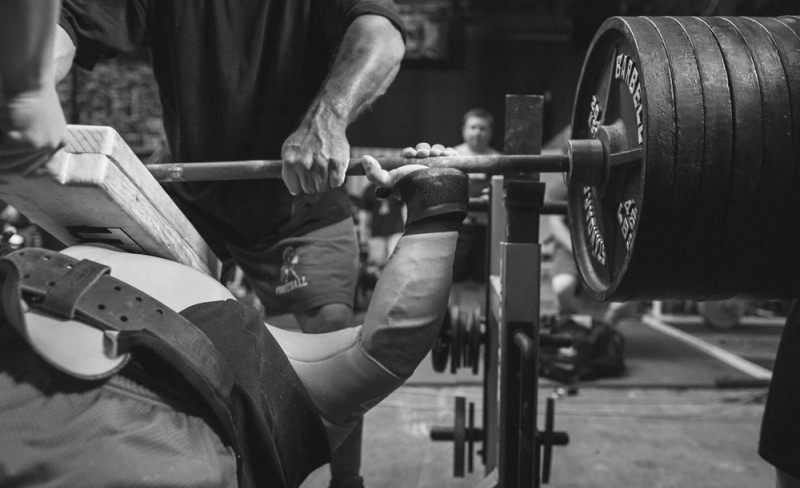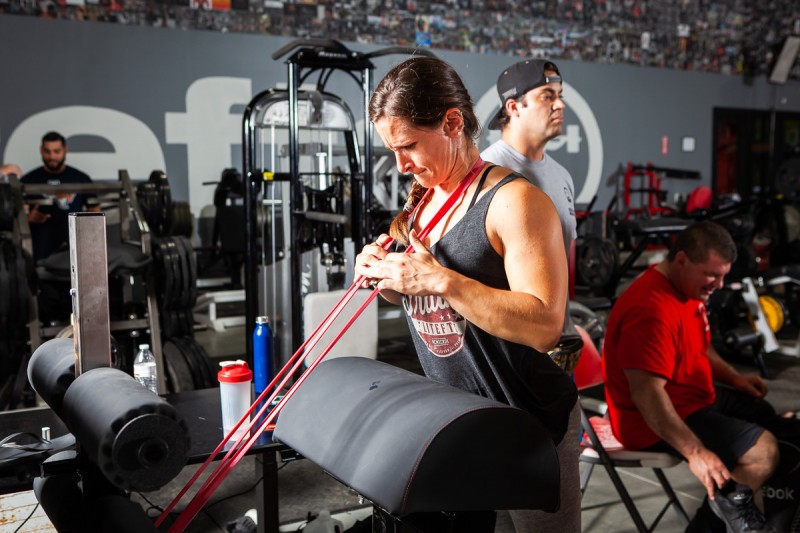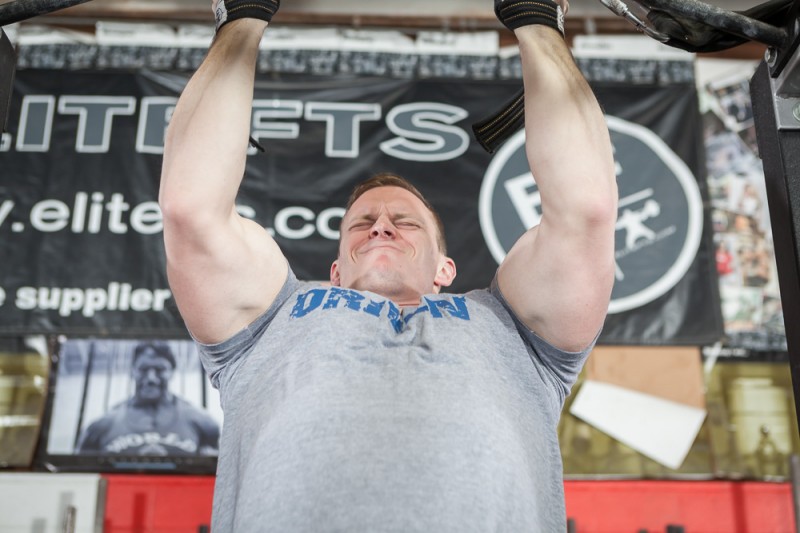
I was lucky. Very lucky. My introduction to strength training was in the early eighties, and the advent of Nautilus equipment was in fashion. I have often said that there has been no significant improvement in training equipment since the invention of the revolving sleeve of the Olympic barbell. Everything is an iteration. A possible exception to that is the Nautilus cam and the subsequent training methodologies applied to it. There is an argument to have that it is equally revolutionary.
If you have an interest, researching the genesis of the cam design is well worth your time. For this article, however, I want to elaborate on the most radical and misunderstood facet of the Nautilus training protocol—the concept of ONE SET TO FAILURE. My intention is not to defend it nor deride it as a total strength training protocol. But rather, I want to extract from it an incredibly valuable idea. That idea is to give everything you have in an exercise effort. The understanding that I learned between giving it all and giving almost all has been priceless. I have learned a great deal about the body, physiology, mechanics, and psychology. But I don't think it is saying too much to claim that the ability to exact a truly maximal effort in an exercise is certainly among the most important things that I have ever learned.
RELATED: The Best Mindset for Maximal Effort
My good fortune to be initially introduced to the idea of pushing your muscle to momentary muscular failure on a single set per body part was what informed me of how to give my full effort on single rep max lifts. I STARTED there. It was how I was taught. Follow this thought experiment...
Let's ask ourselves which rep in a set of ten is THE MOST beneficial. Which rep causes the most change? Which rep causes the most growth? Do they all contribute equally, or are some more productive? To make it simpler, let's decide between either the first three reps or the last three reps. Do we grow more from the beginning three when our muscle is rested and full of glycogen and has no lactate buildup in it, or perhaps from the last three when we can hardly even move? If you believe that you can grow from easy reps in the weight room, you are in for a rude awakening, not to mention a lifetime of plateaus. Instinctively you understand that if the workload is too easy, you have not stimulated growth. You grow from the hard reps. Even without biology, physiology, and chemistry, you KNOW this. Those science things simply confirm it. You grow more from the last three.

But let's return to the initial question. Out of the last three growth-promoting reps, which one is THE MOST stimulating of the three? Rep number 8 (in the set of 10) is hard, but it goes up smoothly. Rep number 9 is just barely doable, and it drags and resists us almost to the end of our ability. But we make it up. Then we get to the dance, finally—the last rep in the set, and it is tough to say whether we will be able to get it or not. It may even stall and laugh at us. If the weight choice was right, this is our limit. It is slow and painful and makes us dig deep. If we get it past a certain mechanical point, we can finish it. If we don't, we surrender to gravity and record the set as a 9. It is a miss, but I suggest it is not a loss.
Did we grow from the last rep? Or just from number 9, which we were able to finish? My question is, which rep created more stimulus for change and adaptation? The 9th rep, which was successful, or the 10th rep that stalled out? Did we grow any from the rep we missed? Or do we only grow from reps we make?
Hold on to your answer for now. Let's review a few things and return to it. We know what makes muscles strong. In a word, TENSION. The more tension applied, in general, the more the muscle gains strength. For our purposes, we will limit our scope of muscular strength to mean single rep maximum lifts. We will set other applications aside for now. Of course, I'm oversimplifying, but the example will hold up.
In a single rep max, there are two major components I want you to consider. First, consider the size of the muscle. This means the cross-sectional area available to present fibrils and fibers to contract—the greater the area, the greater number of elements that "pull" on the tendons. Second is the nerve signal that attempts to get the highest number of contractile elements to "pull" AT THE SAME TIME. The greater the signal, the more elements fire at once and generate force.
You can have lots of cross-sectional muscle area, but if you don't tell it to contract it can't lift a feather. You must turn it on. Having lots of muscle is not enough.
So one way to get more strength is to increase the muscle size. Another way to get more strength is to send a stronger nerve signal. THERE IS NO REASON NOT TO EMPLOY BOTH! Let's concentrate on the second part.
Trying is training. REMEMBER I SAID THAT.
I will answer the question for you. Let me just say this plainly: YOU DO NOT HAVE TO COMPLETE A REP TO GROW FROM IT. In fact, the reps you fail on can potentially be THE MOST growth-promoting of all. I say potentially because the way in which you fail matters a great deal. Here's the rub: If you peter out on a rep and just abandon the effort and yell, "Take it!" you are missing out on training. If you stall a rep and fight like hell to attempt to restart it, you are getting trained. Quit early, and you miss the rep. And you miss the training. Keep trying on a stalled rep and you are teaching your brain to find additional motor units to help next time. That's what this article is all about.
Follow me down the rabbit hole.
I'll explain it as simply as I am able. Stay with me and read slowly. One sentence at a time. If you get squirrely, go back and read it again. It's not too complex. But it takes thinking to get it. You can get it all if you go slow. It makes common sense. If you understand this, you will get stronger this week. No shit.

When you stall a lift, the muscle is creating exactly the same force as the inertia of the weight, which is to say how much it weighs. As it was moving, you had more force transferred to the bar than it weighed. Momentum from that force built up in the mass of the bar, and it moved. But when the force you were producing equaledthe force of gravity acting on the bar, it came to a standstill. It moves neither up nor down. Four hundred fifty pounds of force upward from muscle and 450 pounds of force downward on the bar from gravity equals a stalemate. If you stop trying (or lessen the 450 pounds of force down to 445) the bar will begin to move down toward the ground. You stopped sending the full signal to continue to create the 450 pounds of force. You are pushing with less force than the bar weighs so its inertia overtakes your push. But if you keep trying, you just may find a motor unit or two that is not yet in play creating force. This additional force might be enough to get the bar to move up again. Keep trying!
Here's how motor recruitment works. You have motor neurons in your brain that attach to lots of muscle fibers by way of a motor nerve. They are arranged from just one neuron attached to a few fibers, gradually increasing up to one neuron attached to thousands of fibers.
All motor neurons and all their connected muscle fibers fire on the all-or-none principle. If a motor neuron fires, all the muscle fibers it goes to fully contract. One motor neuron can't fire just half of its fibers. They all go, or they all rest. They don't contract just a little to pick up an egg. To pick up something light like an egg, the brain selects a motor unit that is only attached to a low number of fibers, and those fibers give it all they have...all or none. The reason the egg doesn't break is that the low number of fibers (even though they are contracting fully) only adds up to the weight of the egg. If you fire a motor neuron that is attached to too many fibers, you break the egg. In picking up the egg, the brain starts by selecting motor neurons that have too few fibers to lift it...and ADDS neurons extremely rapidly (in milliseconds) that progressively have more fibers. They do this IN ORDER until there are just enough to lift it and not overdo it.
The majority of muscle is dormant when you lift light weights. But the muscle fibers that are lifting the weight are going all out. Complete contraction. If you wish to lift the egg higher from the table, you must recruit another motor neuron in the brain to add its attached fibers to the effort. They come out of dormancy. If you want to set the egg back down, you have to cancel out motor units and shut off their attached fibers in a smooth sequence.
Here is the thing you need to know about adding more motor neurons to an effort. The body is set up such that you ALWAYS recruit motor neurons from a low fiber number to high. Each neuron you activate is attached to greater and greater numbers of fibers. There is an order. Low to high. So the first motor unit you fire might only have ten muscle fibers attached. The next one may be 25. The next one is 70. The next, 130. The next, 200. The next 500. This goes on up into the thousands. Even tens of thousands and beyond. They keep adding to each other.
During a very hard effort, you may be at a point where the neurons you are firing are attached to 10,000 fibers. THE VERY NEXT MOTOR NEURON COULD BE ATTACHED TO 30,000! The one after that, perhaps 90,000. So if you are struggling to lift a weight, if you can possibly manage to recruit JUST ONE MORE MOTOR NEURON…it could be an incredible addition of fibers contracting (all or nothing, so this means ALL of them help), and that can be enough to complete the rep. You could go from thousands to tens of thousands of muscle fibers if only you can exert the will power to turn on the very next motor neuron in the chain!
The number of neurons increases and they add together their fibers, all firing together, but each new neuron has a bigger contribution to add! The next one you fire has the biggest effect on the force! The next one is the best one, so to speak. If you can't get it to go, you left your best on the table. You were oh so close!

I know this is a bit complicated. Reread the above extremely simplified and paraphrased version of events in motor cortex nerve activation. This is an entire chapter in basic physiology texts that I've attempted to explain in a paragraph or two, so cut me some slack! I'm not really happy with that description. But I have to cut corners and fudge numbers to avoid losing people. Please forgive me and try to see the big picture.
I'll review it. When you ask a muscle to contract, you keep adding motor neurons IN ASCENDING ORDER of number of attached muscle fibers. Low to high. Each motor neuron has more muscle fibers attached to it. Even if you are lifting a sledgehammer, you MUST START with the low number of fibers that you might use to lift a ping pong ball first. You'll then ADD neurons (in milliseconds) in ascending order up to higher and higher numbers of attached muscle fibers, continuing up until the corresponding force is produced to move the hammer. They all contribute in order to produce greater and greater force. YOU CAN'T SKIP THE LOW-END UNITS AND GO RIGHT UP TO THE HIGHER ONES. You must follow the order. This is just how it is.
Every time you add the next unit to the job, you get a larger and larger contribution of fibers. So when you are just about to give up and believe that you can not lift the weight, YOU ARE ON THE VERY BRINK OF ADDING THE GREATEST NUMBER OF FIBERS TO THE ATTEMPT. The next neuron is attached to a huge number of fibers. Not just a couple more but the greatest increase in number in the effort so far! This is why you should keep fu@#%^g trying! If you can just get a few more neurons into the game, even just one or two, you get thousands of fibers to begin pulling. Your force production goes way, way, way up. Let me repeat that in all caps and in italics:
IF YOU CAN JUST GET ONE OR TWO MORE NEURONS TO FIRE, YOUR FORCE PRODUCTION GOES THROUGH THE CEILING.
It's called exponentiality.
If you are "trying your hardest," do you really believe that you have recruited every single motor neuron that you have in your brain? I'll tell you flatly that you have not. The really, really BIG ones only come out LAST to play! Remember the order. Low to high. Small to big. The best, biggest, baddest, strongest units are the very last ones in the chain.YOU ONLY GET TO THEM BY GOING BEYOND THE CURRENT LEVEL YOU ARE TRYING. Oh, make zero mistakes, they are there waiting for you, but they are the hardest to reach. You must try harder to get them to fire. This is NOT dcentered on the muscle. It is all in your head. Really, in your head.
This is the background you should know. But even if it is not crystal clear to you in physiology terms with fibers and units and neurons, it just makes common sense that you MUST TRY HARDER IF YOU WANT TO ACTIVATE MORE MUSCLE IN AN EFFORT. Period. I'm trying to motivate you to do so by explaining that if you get just one more circuit to go, you get big, big numbers of muscle fibers to respond. So only one little improvement in your head will lead to enormous improvement at your muscle. Hold on to that concept. One more mind step equals thousands of muscle steps. Get it?
Now, this brings us to the crux of the article. Try harder. What does that mean to you?
Well, what I'm certain of is that you can imagine ONLY the hardest effort you have ever given to date. It would be much the same if I asked you to picture the greatest pain that you can. It would in some way ONLY reference the worst pain you have ever experienced…so far. So when I say," try harder" and you interpret that, I am afraid that much is lost in translation. Words in an article fail miserably at getting down to it with this issue. It is much easier to show this in the flesh. It is easier for me to show this to you in a gym than explain it to you in print. Bear with me. I'm trying.

NEW: Dan Roche Resurrects An Old School Gym
Whatever you think trying hard is, I'm sure we will disagree. I often say, "You are the easiest coach that you ever had!" But this has nothing to do with me or my approval or disapproval. You must use yourself as the metric. You must compare whatever you believe your best effort to be to what you are doing now...and go beyond. All it takes to go miles beyond is to go one step beyond today. All you have to do is to try and try and try...ad infinitum. You can not stop trying.
The advantage that I had early on—before I even learned all the proper names of the muscles, the difference between a ligament and a tendon, what's inside a muscle that makes it contract—I was taught to keep trying no matter how hard you think you're trying. I was implored with great prejudice to try even harder than I was at the time, even though I was convinced in my mind that I had nothing more to give.
I was daily coached and taught and screamed at, in ear piercing tones, that I was NOT TRYING HARD ENOUGH and that I did, indeed, have more to give. It was ingrained in me that I was simply not engaging my will strenuously enough and that if I were to apply myself to the task fully I would be rewarded with success. It was not a failing of my muscle, but of my commitment to give what is required in terms of mental drive. I just was not paying the price. MENTALLY.
I was indoctrinated into a culture of will and of mind over muscle. I was promised that I had what it took inside me and that it was my own lack of surrender to creating an incessant resolve to give effort to overcome. I was shown how by demonstration after demonstration of an outpouring of complete and nearly reckless abandon to submit the requisite energy to lift the next rep. Intensity had a meaning all its own to us.
I watched. I tried. I failed. I grew. I tried again. And again and again. Each failure lasted longer and longer on each rep before I was unable to sustain the effort even to hold the weight up. But in those precious moments, and moments is all it takes, I was getting closer and closer to accessing the next motor unit. The day that it fired, I watched, straining my eyeballs out as the weight gently, slowly inched upward. At the point just beyond the stick, I ripped it all the way home. YOU ONLY NEED TO EXPERIENCE THIS ONE TIME TO UNDERSTAND IT FOREVER.
I learned this first on preacher curls. I learned to try harder.
The truth is that it is never this easy again. Each motor unit in the order requires more and more will to get it to fire. But it is connected downstream to an ever greater number of power-producing muscle fibers. That is the rub. Instead of getting easier and easier to "try harder," it continues to become more difficult. NOBODY EXPECTS THIS. I suppose as nobody expects the Spanish Inquisition, but it makes common sense. The really, really big guns only come out in emergencies! You really have to sound the alarm and demand them to exert their sizable and awesome force. If you want it, you really have to want it. The harder you try, the harder it is to try even harder next time!
But after the first breakthrough, you KNOW it is in you. And since you got there once, you know the way. It simply comes at a higher cost. This is why I constantly harp and preach and bitch and moan about mental sharpness. You have to train your brain to listen to you. You have to engage your thoughts and thought process. You have to become a disciplined thinker, or you will struggle endlessly with this. How can sharpening your mind make your muscle stronger? You tell me now. If you understand what this article says, you can tell me. Right?
The mind tells the muscle what to do. We have to be in agreement about that. The REALLY interesting question is...What tells the mind to tell the body what to do? In other words, how do you engage your will to lift your right arm or your left arm?. Your mind tells the right or left arm to move, but where did THE CHOICE of the right or left come from? Pray tell?
That moves us beyond the scope of this article, but it highlights the need to at least begin to sharpen the mind to get us closer to answering that. This practice of trying harder will put you closer in touch with your will. They call it "The Seat of the Will" in some textbooks. But by trying harder every day, every set, every so-called last rep, you will intuitively become more familiar with it. You will touch it more and more. It will become commonplace. When you finally figure it all out, promise to let me know! I've been at it for a long time!
My advice on this is to move from higher rep sets to failure back in the direction of a one-rep max. Learn to push past the pain, the burn, and the loss of feeling and keep trying to finish the rep. The point is to continue to try to finish even when the bar comes to a dead stop. THE LONGER YOU TRY AT THIS POINT, THE GREATER THE INROADS TO ACCESS OF GREATER MOTOR NEURONS. Even tiny fractions of seconds count. The nerves fire in milliseconds! In one one-thousandths of a second. Just hanging in there, a blink longer will pay off...if you keep adding to it. Blink by blink by blink. You have no idea how far off you are at any given moment from firing the next neuron. You might be one breath away or one blink away. Try until you can't try anymore. Suffer. Persist. Be dedicated. Be immovable in resolve. Be all those things that war heroes talk about when overcoming impossible odds.
As you have a few breakthroughs, you can begin to lower the reps and bring more weight to bear. This is a different motor pattern, it is true, but the process is the same. Willfulness. Unceasing effort. And above all, the confidence of an indomitable spirit. You must not be persuaded that any weight can stop you. At some point, you will find yourself remembering these lessons subconsciously in maximal attempts. You don't even have to think about it. You will know it in your body and your bones.
I do not want this to devolve into a motivational discussion. There is plenty of room for that elsewhere. Get to the gym and take this approach on a set: don't give up. Tell yourself or anyone around that you will make certain not to give up on this set too easily. Say, "I'm going to give more than I ever have before in my life on this next set," then do it. Then do it again. And so forth.
I do not care who you are or what you lift. You can try harder.
This is one secret to lifting from the inside. Now you know.











3 Comments